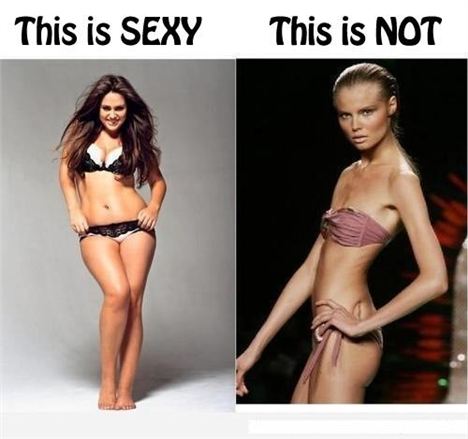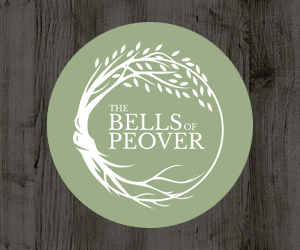‘ONLY Dogs Go for Bones’ is a Facebook Page with around 160,000 likes.
‘Real men go for curves’ it states next to a picture of a girl with a figure eight physique. Whilst the page should be written off as a juvenile grasp for attention, it does reflect the common backlash to fashion’s preference towards pin thin that says, ‘curvy women are ‘real women’ and slim women are not.’
It seems nobody wants to hear grimaces from the women who could blitz an all you can eat buffet without putting on a pound.
When Dove launched its ‘Real Beauty’ campaign in 2004 there was a distinct lack of the tall thin variety of woman. It was a celebration of the nation’s average dress size - a size 16 - the women who aren’t regularly featured on our advertisements and the woman unlikely to be seen sashaying down the catwalks; the majority. The term ‘real woman’ is befit because they don’t fulfil what would normally be an advertisers’ fantasy.
As a result of this campaigning, the term ‘real woman’ has become synonymous with the words ‘curvy’, ‘full figured’ and ‘womanly’.
It has meant re-embracing pre-waif beauty conventions from the past. My Grandma’s era, where broad birthing hips and wet nurse sizeable bosoms were considered sexy and feminine. My mother’s era too. Mum, once a size 4, recalls her regime of wearing “two pairs of trousers” because “being skinny back then was shameful.”
By and large, most believe the rejection of ‘unnatural skinny body types ’ as a welcome change.
However, as a result, naturally slim women have felt ostracised and coerced into feeling ashamed about their waif-like physique.
“These campaigns seem to ignore that not everyone who is the same size as supermodel Adriana Lima, looks like Adriana Lima and will also feel similarly inadequate standing next to a Victoria Secret model” said Rachael Fraser, 26-years-old from Liverpool.
As a UK size 6, Rachael (5 ft 4) would be an American size 2, just one size above a size zero.
“There have been times when I’ve fit into a size 4 and it’s never been something I’ve wanted or tried to achieve. If anything I’ve always been trying to gain weight.”
Rachael has felt excluded by the phrase ‘real woman’, believing it to be a term that rejects that ‘real women’ can sometimes come in petite packages.
She said, “I despise the line ‘real men go for curves’. It’s as if to say having less curves makes me less of a woman.”
Rachael admitted that for years she was made to feel that something was wrong with her.
“Friends would ask me all the time if I ate. I’ve been made to feel as if I looked ill - like I had an eating disorder when I’m perfectly healthy.
“People assume that I’m trying to stay slim on purpose, they don’t believe that my size is not my choice and it’s just the way I’m made.”
With what seems to be an epidemic of women battling to lose weight it’s hard for some to conceive that there are women who struggle just as much to pile on the pounds – and that they want to.
Manchester based nutritionist, Nadia Mason said: “There is a well known phenomenon called 'constitutional thinness'. Women who are constitutionally thin, who actually eat around the same number of calories as normal weight women.”
 "I despise the line 'real men go for curves'"
"I despise the line 'real men go for curves'"
Nadia explained that “while anorexic women show imbalances in hormone levels, these imbalances are not present in constitutionally thin women, yet some studies have found that these naturally thin women simply and unconsciously expend more energy during the daytime - they spend more time standing, they move around more and they fidget.”
Of course Rachael makes up the minority of women who are ‘constitutionally thin’, making it hard for some to empathise with slender women who feel insecure about their weight. It seems nobody wants to hear grimaces from the women who could blitz an all you can eat buffet without putting on a pound.
Further still, because of the media’s apparent preference to a smaller frame, it has meant some slim women have had to succumb to a level of criticism and vitriolic comments that we now deem unacceptable when it comes to people that are overweight.
“I would never tell someone that they look too fat, so why do people think it’s okay to say I look too thin?” questioned Rachael.
“On the beach a man came up to me and laughed saying my boobs were small – after that wearing a bikini was an ordeal”.
Rachael isn’t alone in feeling self conscious about not having a large bust and boob jobs in the UK are still the number one procedure, above liposuction. She had once considered the procedure but now feels comfortable with her body and shape.
Of course, not all accusations of being too thin come from spitefulness and have mostly emerged from the fear of the growing number of girls with eating disorders. Campaigns such as Say No To Size Zero push to rid the media of super skinny models directly because of the impact it has on women’s self image. Even well known skinny-mini Victoria Beckham banned ‘too thin’ models from her runway shows.
When it comes to promoting a healthy physique, agreeably there must be a focus away from unattainable body proportions, but that shouldn’t necessarily include the smaller frame. There needs to be calls for a distinction between naturally slim women and the women who are dying to be slim.
Women’s bodies are of course a fruit bowl filled with a mix apple, pear and orange body shapes.
Real women are more than aware of this.
Nadia Mason is a nutritional therapist who offers private consultations in the Manchester and Cheshire areas. You can contact her at nadia@discovernutrition.co.uk or through her website www.discovernutrition.co.uk













